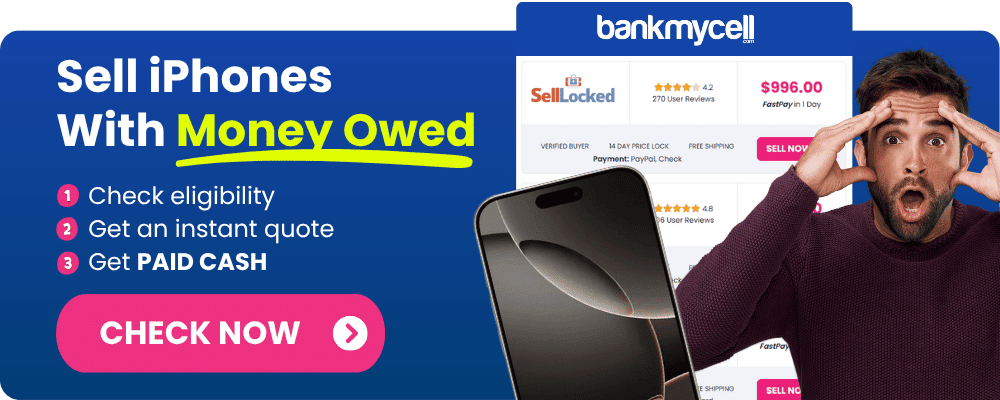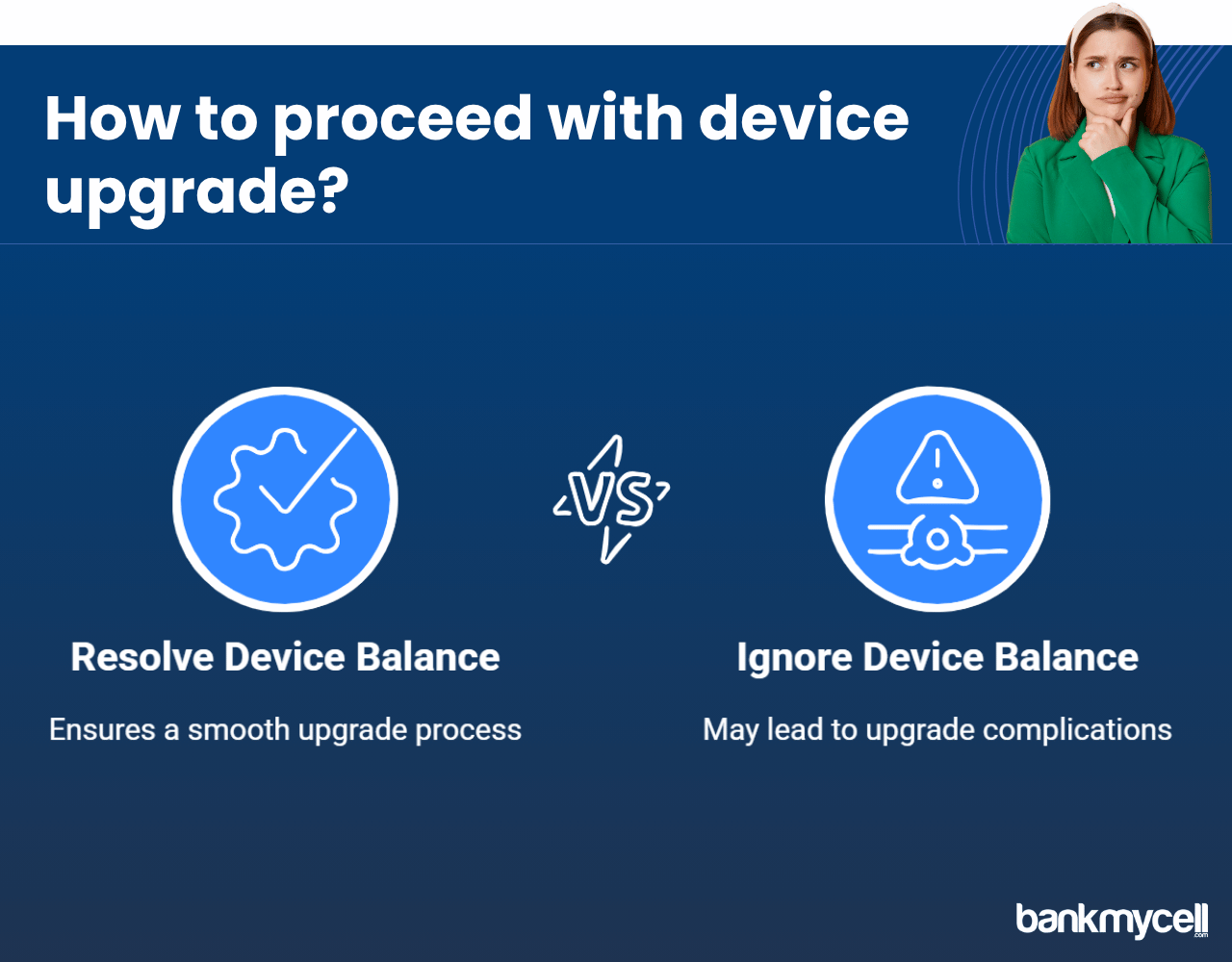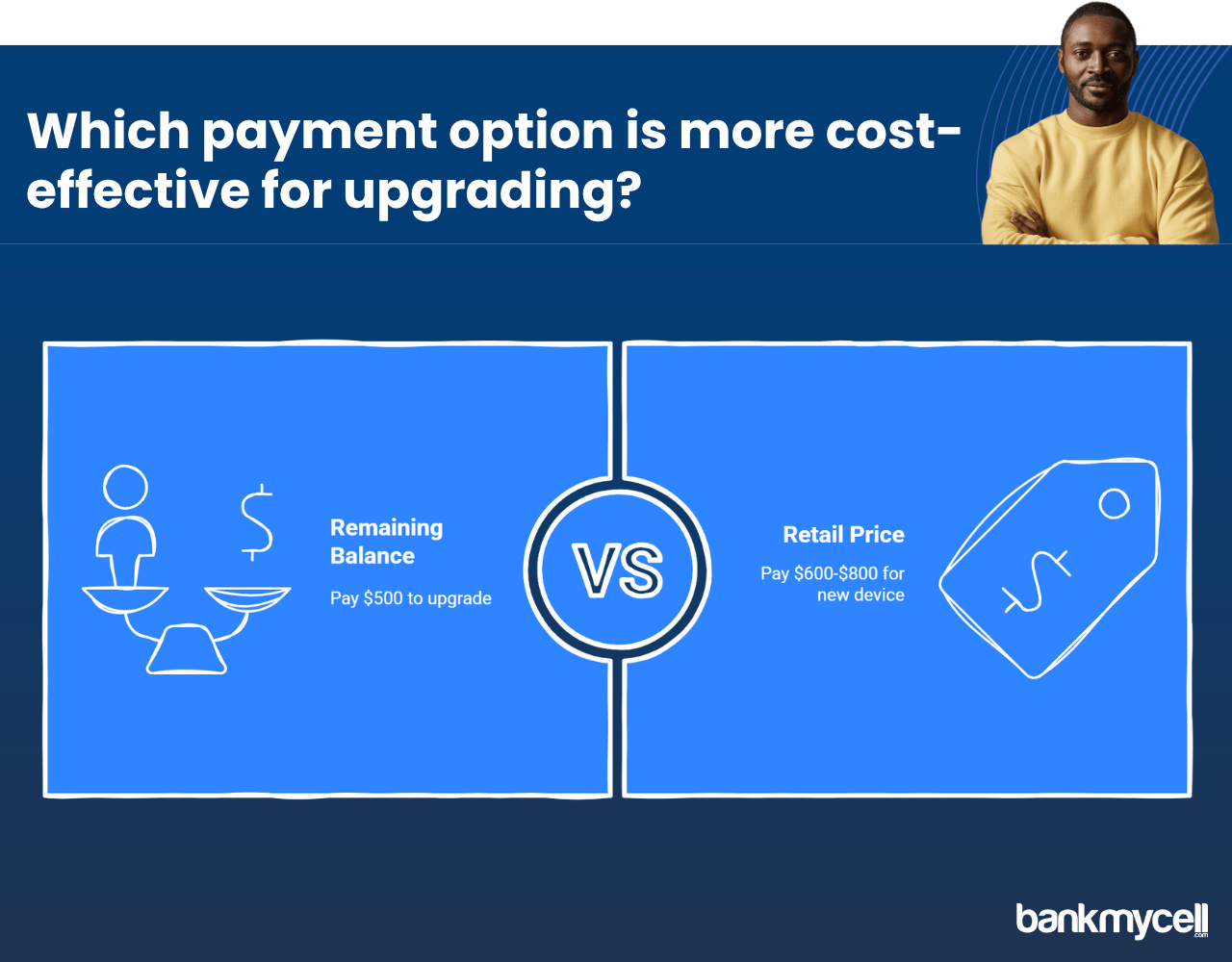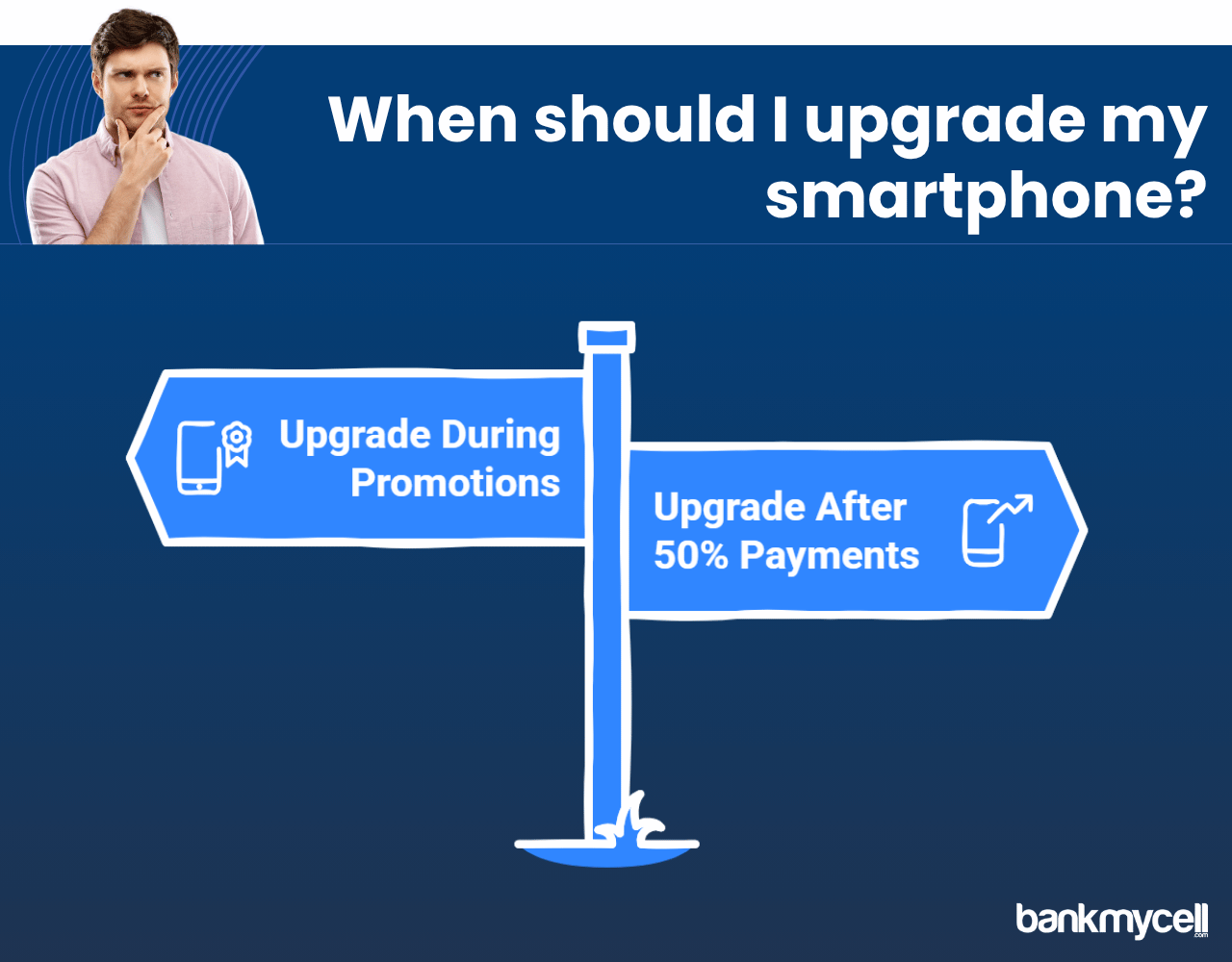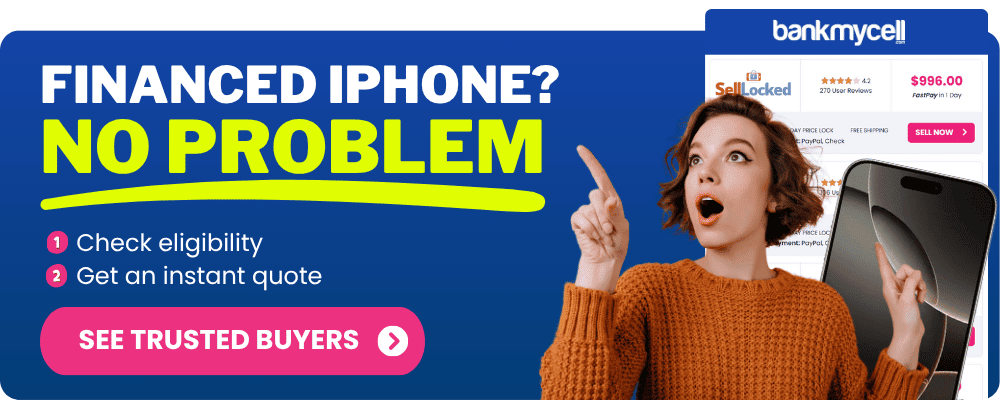Can You Upgrade Your Phone Before It's Paid Off? Early Upgrade Options
60-Second Summary
Main Takeaways
Yes, it’s possible to upgrade your phone before it’s paid off, though you’ll likely need to pay down at least 50% of your device’s retail cost first.
Check each carrier’s requirements to see if your device qualifies.
Early Upgrade Options
Carrier Programs
- Verizon: Trade in device after making 50% of device payments. Old balance gets wiped.
- AT&T Next Up: Pay $5/month fee, and can upgrade at halfway point.
- T-Mobile Jump! $9-$18 per month, with protection included
- Apple iPhone Upgrade Program: Make 12 monthly payments and can upgrade with AppleCare+ protection
Alternative Solutions
- Third-party buyback services will often pay $100-$200 more than carrier trade-ins
- Sell privately to recoup more than remaining balance and earn additional cash
- Pay to a new buyer (when allowed by carrier)
- BankMyCell buyback service offers high, competitive quotes that may beat carrier trade-in values.
Total Cost of the Upgrade
Total cost of early upgrade cycle: If upgrading every 12 months, you’ll be paying $40-$50/month indefinitely instead of standard 2-year payments. That’s $1,000+ extra over five years.
Figure out your total cost by comparing your device’s remaining balance, your carrier’s trade-in value offer, and third-party buyback quotes.
How to Save Money
- Upgrade strategically: wait until a new phone model release to receive higher trade-in bonuses
- Explore all options – carrier trade-in, carrier buyback, manufacturer programs, and third-party services, etc.
- Negotiate your upgrade: work with your carrier for loyalty discounts, waived fees, or special promotions
- Read more cost-saving strategies
Bottom Line: In most cases, it’s better to finish out your existing contract before upgrading, to minimize costs over time. However, if you want to upgrade early, be sure to explore all available options for selling your current device, including through third-party buyback services that pay more than carrier trade-ins.
Get the most value from your current device. BankMyCell accepts all phones, including damaged models, while protecting your data security. Get competitive buyback offers from trusted shops with free shipping. Sell your current device for top dollar toward your upgrade instead of accepting carrier trade-in values.
Disclaimer: You can sell financed iPhones, but you are still responsible for the finance payments. The sale does not end your responsibility to continue your contract payments. Always check your carrier’s terms if you are not clear,
| TODAY'S BEST iPHONE BUYBACK OFFERS | |||
|---|---|---|---|
| Device | Financed | ||
| iPhone 16e | $410.00 | Compare | |
| iPhone 16 Pro Max | $1095.00 | Compare | |
| iPhone 16 Pro | $920.00 | Compare | |
| iPhone 16 Plus | $610.00 | Compare | |
| iPhone 16 | $475.00 | Compare | |
| iPhone 15 Pro Max | $780.00 | Compare | |
| iPhone 15 Pro | $700.00 | Compare | |
| iPhone 15 Plus | $385.00 | Compare | |
| iPhone 15 | $395.00 | Compare | |
| iPhone 14 Pro Max | $620.00 | Compare | |
| iPhone 14 Pro | $450.00 | Compare | |
| iPhone 14 Plus | $315.00 | Compare | |
| iPhone 14 | $285.00 | Compare | |
| iPhone 13 Pro Max | $330.00 | Compare | |
| iPhone 13 Pro | $270.00 | Compare | |
| iPhone 13 Mini | $150.00 | Compare | |
| iPhone 13 | $165.00 | Compare | |
| iPhone 12 Pro Max | $200.00 | Compare | |
| iPhone 12 Pro | $160.00 | Compare | |
| iPhone 12 Mini | $130.00 | Compare | |
| iPhone 12 | $120.00 | Compare | |
| iPhone 11 Pro Max | $135.00 | Compare | |
| iPhone 11 Pro | $140.00 | Compare | |
| iPhone 11 | $130.00 | Compare | |
| * Best market prices updated January 4th 2026 | |||

Data Source: BankMyCell compares over 100,000+ quotes and customer reviews from 20+ trusted buyback stores every 15 minutes via our data feeds, making us America’s #1 time-saving trade-in supermarket.
Do you find yourself tempted to buy a new iPhone before your current device payment agreement ends?
Flagship phones that cost more than $1,000 are released every year which leads many people to want to upgrade before their payment plan finishes. Better cameras and faster processors together with new features make it tough to ignore the appeal of the latest tech.
Here’s the problem:
Your carrier financing plan requires payments over 24-36 months yet new smartphone models emerge annually which results in an unsatisfying mismatch between your upgrade aspirations and financial commitments.
And that’s not all…
Early upgrade options frequently include hidden costs or requirements which may transform an apparently good deal into a costly choice when you decide to upgrade your device.
What financial and contractual consequences occur when you switch to a new phone while you still have outstanding payments on your current one?
Signing up for a phone financing plan with carriers like Verizon or T-Mobile means you enter into a payment agreement for the device. Ownership of the eligible smartphone only transfers to you after completing all payment obligations. Trying to upgrade your phone early creates several challenges.
This means:
- Your current device balance continues to remain outstanding
- Your qualifying device is tied to a financial arrangement with the carrier.
- You must resolve this device balance before or during the upgrade procedure.
Think about it:
During the middle of a 24-month phone payment plan you owe about half of the initial purchase price for the device. The debt from your current phone remains unpaid when you choose to switch to a new eligible device.
Verizon and T-Mobile have devised multiple early upgrade programs that enable customers to renew their devices more often than the original payment agreements permit.
Discover your phone’s trade-in value while still having unpaid balances. BankMyCell enables you to assess buyback offers for iPhones regardless of your device balance status.
Carrier Early Upgrade Programs Explained
Major carriers provide early upgrade programs but their terms and requirements vary greatly for well-maintained accounts.
Verizon's Early Upgrade Options
Verizon allows early phone upgrades through their device payment agreement only when you’ve paid 50% or more of the phone’s cost. Once you hit this threshold:
Here’s how it works:
- Bring your fully functional current device for trade-in
- Your old phone balance gets erased when you trade it in.
- Initiate a device payment contract with Verizon for your new phone.
But here’s the truth:
By starting this process you enter into another 24-month payment commitment for your new device. Frequent use of Verizon’s upgrade option makes device payments a permanent aspect of your Verizon mobile service.
AT&T's Next Up Program
The Next Up program from AT&T requires an extra $5 monthly fee which adds to your existing device payment amount. With this early upgrade program:
- You are eligible for an upgrade when your device payment reaches halfway completion.
- Exchange your existing device for an upgrade only if it has minimal damage and remains in good condition.
- Your remaining payments are forgiven
- After trading in your old phone, you start paying for your new phone under a new payment agreement.
The advantage of this method:
- More predictable upgrade cycle
- A significant down payment isn’t required when you choose to upgrade your device.
T-Mobile's Jump! Program
T-Mobile’s Jump! The program features both options for upgrading devices early and protection plans for devices. T-Mobile charges $9-$18 monthly for this program depending on your device.
The Jump! program allows device upgrades once you’ve paid half of your phone’s cost.
Your device receives protection from damage as well as loss and theft
You must trade in your current device
Your remaining payments are forgiven
The device protection feature in this program gives you added advantages that could justify the monthly fee depending on your situation with T-Mobile.
Disclaimer: You can sell financed iPhones, but you are still responsible for the finance payments. The sale does not end your responsibility to continue your contract payments. Always check your carrier’s terms if you are not clear,
Apple's iPhone Upgrade Program
When you buy your iPhone through Apple’s upgrade program you:
- The program allows you to upgrade your iPhone after completing 12 monthly payments.
- The program includes AppleCare+
- Your existing iPhone must be in good working condition to qualify for trade-in under the program.
- When you participate in the upgrade program, you get a new phone and initiate a new 24-month payment period.
The upgrade program targets individuals who wish to purchase a new iPhone annually while providing a different payment structure than carrier device agreements.
Looking for alternatives to carrier upgrade programs? BankMyCell provides better buyback opportunities which could surpass your carrier’s trade-in value.
Financial Considerations For Early Upgrades
It’s crucial to evaluate the financial consequences of your choice to upgrade before you finish your existing plan.
Cost of Remaining Balance
You must settle the outstanding amount on your existing device if your carrier lacks an early upgrade option or if your credit evaluation fails. This can be substantial:
- The remaining balance for a $1,000 iPhone with 12 months left on a 24-month installment plan amounts to approximately $500.
- Devices that represent the top-end or have recently been released may carry a retail price figure ranging from $600 to $800.
Consider this:
Do the upgraded features justify the extra payment needed after starting your new smartphone plan?
Trade-In Value vs. Remaining Balance
There are cases where the trade-in value of your phone can surpass what you still owe on it.
Here’s a typical scenario:
- Remaining balance: $400
- Trade-in value offered by carrier: $350
- Trade-in value through third-party buyback services: $500
A third-party sale of your device will pay off the remaining balance and may give you additional funds for your new phone purchase.
The Hidden Cost of Perpetual Payments
Using early upgrade options consistently traps you in an endless loop of payments.
- Standard 24-month financing: 24 payments, then $0/month
- When you choose to upgrade every 12 months you will make continuous monthly payments of $40-$50 indefinitely on your account.
Users will spend at least an additional $1,000 if they opt for early upgrade programs over a span of five years.
Strategies To Minimize Costs When Upgrading Early
These strategies will help you reduce financial burdens when you decide to upgrade your phone before completing your payments.
Time Your Upgrade Strategically
The best times to upgrade include:
- The best time to trade in eligible smartphones is during promotional events which typically coincide with new iPhone pre-order periods.
- Carriers commonly provide special incentives to customers who choose to upgrade their devices.
- Once you have fulfilled 50% of your payments towards eligible upgrade programs you can begin upgrading.
During new phone launches carriers often provide boosted trade-in values and occasionally double standard values for devices that meet requirements.
Compare All Available Options
Don’t automatically accept your carrier’s upgrade offer:
- Check your carrier’s trade-in value
- Obtain manufacturer upgrade quotes from Apple and Samsung.
- Compare offers from third-party buyback services
- Consider selling your device privately
The highest and lowest trade-in offers for the same eligible smartphone can differ by $100 to $200.
Negotiate With Your Carrier
Verizon and similar carriers prefer to maintain positive relationships with their customers and may extend special offers to support this goal.
- Ask about current promotions for existing customers
- Inquire about loyalty discounts
- Mention competing carriers’ offers
- Request waived activation fees or other concessions
Your phone upgrade through your current plan could become much less expensive after making just one call.
Alternatives To Early Upgrade Programs
When traditional early upgrade options fall short for your needs consult these alternatives instead.
You can sell your old phone on a third-party platform to settle your outstanding balance.
Instead of trading in through your carrier:
- A third-party service or marketplace offers you the opportunity to sell your phone.
- Apply all the money you get from selling your phone to clear the rest of your payments
- You should use any remaining funds to help purchase your new phone.
Customers who upgrade early tend to find more value through this method compared to carrier trade-in programs.
Transfer Payment Responsibility
Certain carriers give you the ability to assign your payment responsibility to another person.
- Your remaining device payment agreement transfers to the buyer after the sale.
- You’re released from financial obligation
- You have the flexibility to establish a new payment agreement for a device.
To select this option you need to find an individual who will take over your payments and successfully complete the carrier credit approval process.
Keep Your Current Device Longer
Sometimes the smartest financial decision is patience:
- Finish paying off your current device
- Enjoy a period of lower monthly bills
- Save the difference toward your next upgrade
- Proceed to upgrade only after you have completely paid off your original smartphone.
Adopting this strategy stops endless payments and results in long-term savings compared to continuous early device upgrades.
Wrapping It Up
People can upgrade their phones early using different programs but they need to assess financial consequences and explore their options carefully.
You will save money and choose the best upgrade path by learning about your carrier’s upgrade programs and evaluating trade-in and buyback options while planning your device replacement timing.
Although new phone features can be tempting, you should typically finish paying off your current device before upgrading to make sound financial decisions. When you choose to upgrade your device early you should fully understand all costs related to early upgrade options.
Disclaimer: You can sell financed iPhones, but you are still responsible for the finance payments. The sale does not end your responsibility to continue your contract payments. Always check your carrier’s terms if you are not clear,
Helpful FAQ's
Can I upgrade my phone at any time?
You may technically upgrade your phone at any time but you must pay the full remaining balance unless you’ve crossed the typical 50% payment threshold required by most carriers.
You can technically upgrade your phone whenever you want but you generally have to settle any outstanding balance completely unless you’ve reached the required 50% payment threshold for early upgrade programs. Device upgrade policies differ among carriers regarding the timing of upgrades.
Will upgrading early affect my credit score?
Your credit score remains unaffected when you upgrade early through carrier programs provided you adhere to their rules and keep your account current. Not settling any outstanding balance when needed might trigger negative reporting on your credit history.
Am I allowed to retain my current phone when I want to upgrade ahead of schedule?
Trading in your old device is mandatory when you use an early upgrade program that cancels your remaining balance. To upgrade to a new eligible smartphone while retaining your original device you must fully pay off its remaining cost.
What happens if my phone is damaged during trade-in?
Devices with significant damage during trade-in may disqualify you from early upgrade programs or cause you to incur extra fees.
Early upgrade programs generally mandate that the device you turn in functions properly. Program participants with damaged devices may face extra charges or lose eligibility for the program. Carriers such as Verizon or T-Mobile usually reject smartphones that have cracked screens or water damage even though they accept phones with minor wear and tear.
Is it cheaper to buy phones outright vs financing?
Buying phones outright normally results in lower overall costs due to the absence of interest charges compared to financing options.
Purchasing devices outright tends to cost less over time because it eliminates interest payments and frees users from mandatory upgrade schedules. The expensive upfront cost of flagship smartphones leads many consumers to find device payment agreements more feasible.
